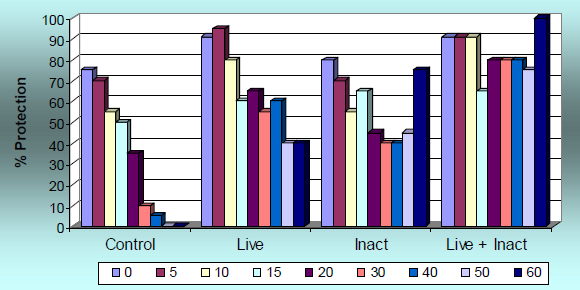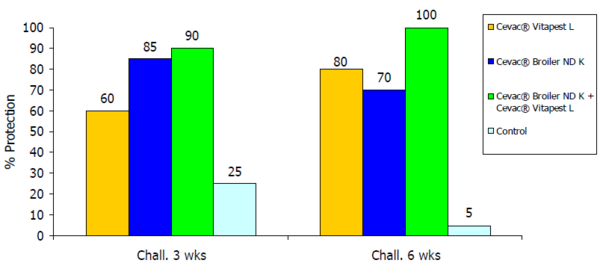...
--> Introduction
--> Live or inactivated vaccine?
--> Immunity
--> Vaccine strain
--> Conclusions
...
VACCINATION AGAINST NEWCASTLE DISEASE IN THE HATCHERIES
By Dr Marcelo PANIAGO, DVM, MSc, MBA, Regional Market Manager for Poultry
CEVA Animal Health Asia Pacific - Petaling Jaya, Selangor, Malaysia
.
INTRODUCTION
Newcastle Disease (ND) is a highly contagious disease which varies widely in the type and severity of symptoms. It is one of the main barriers for international trade of poultry and poultry products and the global impact of virulent ND is enormous. In Asia, this disease is endemic and its prevention constantly challenges even very experienced veterinarians.
Vaccination has an important role in the prevention of ND even though an ideal vaccination program can not be easily given as it would depend on level of challenge in the field, disease control polices in the country, type of birds (broilers or layers), vaccine strain, size of the flock, past performance of vaccination programs, etc. However, the vaccination in the hatcheries has been used throughout the world in broilers, layers and breeders.
^ Top Page
.
LIVE OR INACTIVATED VACCINE?
Since late 60’s, the efficacy of this association of live and inactivated vaccines against ND in the hatcheries has been extensively investigated. In 1978, in one of these experiments, Bennejean and co-workers deeply investigated this vaccination in the hatcheries. Specific Pathogen Free (SPF) day-old chicks were divided into four groups. One group was vaccinated with live vaccine through ocular route, the second group was injected subcutaneously with inactivated vaccine and the third group received both live and inactivated vaccines. One group of birds was kept as unvaccinated control. Afterwards, these groups of birds were challenged through ocular route, using Ploufragan strain, at zero, 5, 10, 15, 20, 30, 40, 50 and 60 days after vaccination. The results are showed in the graphic 1.
Graphic 1 Protection against challenge in SPF birds
It is very interesting to note that at day zero (just 4 hours after vaccination), birds which received live vaccine achieved 60% of protection. The same level of protection was reached by the association of live + inactivated vaccines. Moreover, the control group and the group of birds vaccinated only with inactivated vaccine did not show any protection at day zero. Without any doubt, this protection is due to local immunity induced by the live vaccine. Thus, as inactivated vaccines do not stimulate local protection, it is possible to notice that birds vaccinated with it did not have any protection at day zero.
In the same way, four groups of commercial day-old chicks (DOC) with high level of maternally derived antibodies (MDA) were vaccinated either with live, inactivated vaccine or using a combination of live and inactivated vaccines. The control group did not receive any vaccine. Challenges were performed in the same way from day zero (only four hour after vaccination) to day 60 and the results are summarized in the graphic 2.
Graphic 2 Protection against challenge in DOC with MDA
In this case, the control group showed some level of protection which waned as the MDA declined. As early as 4 hours after vaccination, the group which received live vaccine showed better protection as compared to the control group. The same improvement in the early protection was observed in the group which received both live and inactivated vaccines. Overall, the best protection throughout the trial was achieved by the association of live and inactivated vaccines.
CEVA Santé Animale has also extensively investigated this association of live and inactivated vaccines in the hatcheries. In one of these trials, the association of Cevac® Vitapest L and Cevac® Broiler ND K to induce protection against ND challenge was evaluated. Commercial broilers aged one day were vaccinated in the hatchery using Cevac® Vitapest L alone, Cevac® Broiler ND K alone and Cevac® Vitapest L + Cevac® Broiler ND K. At 21 and 42 days, samples of 20 birds were taken, transported to the laboratory and challenged by intramuscular route with 106 ELD50 of Hertz 33 strain.
The results can be seen in the graphic 3.
Graphic 3 Field efficacy: ND protection
As it was observed by Bennejean and co-workers, the association of a live vaccine (Cevac® Vitapest L) with an inactivated one (Cevac® Broiler ND K) induced the highest level of protection whenever the challenge was carried out (3 or 6 weeks).
^ Top Page
.
IMMUNITY
The use of live ND vaccine in the hatcheries is extremely beneficial as it induces local immunity in the respiratory tract. This local protection, which comprises cell-mediate immunity (CMI), IgA and interferon, is able to afford protection by preventing or reducing virus replication in the respiratory epithelium. On the other hand, the major advantages of the oil-emulsion inactivated vaccines are the very low level of adverse reactions in vaccinated birds and extremely high levels of protective antibodies of long duration that can be achieved.
Therefore, the association of both live and inactivated is vaccines is strongly recommended in case of high field ND pressure as the live vaccine will stimulated the local immunity, responsible for increasing the protection in early stages of the birds’ life and the inactivated vaccine will induce high and long-lasting humoral immunity.
^ Top Page
.
VACCINE STRAIN
Another important point to be taken into consideration is the strain of the live vaccine to be used in the hatcheries. ND virus strains are classified accordingly to their Intracerebral Pathogenicity Index (ICPI) and the higher is the ICPI the more severe is the post-vaccination reactions (PVR). Losses due to PVR have become a constant threat for the profitability of poultry operations and the modern poultry industry can not afford to have such losses. Moreover, lentogenic respiratory strains replicate in the respiratory system, and it is frequently irritated by the presence of dust, ammonia and Mycoplasma gallisepticum. Consequently, the use of such strains could lead to unacceptable PVR.
Table 1 Newcastle Vaccine Strains
For these reasons, manufacturers have invested in developing vaccines which are protective and safe at the same time. Apathogenic enteric strains mainly replicate in the digestive tract and therefore they are safer than lentogenic respiratory strains. Furthermore, these strains have shown the same efficacy as lentogenic ones.
Hence, the use of such apathogenic enteric strains, like Cevac® Vitapest L, in the hatcheries has became more and more common and whenever Mycoplasma is present their use becomes almost compulsory to avoid huge losses due to PVR.
^ Top Page
.
CONCLUSIONS
The association of live and inactivated vaccines against ND in day-old chicks induces better protection against challenge, higher level of circulating antibodies and long-lasting immunity. The benefits of this combination are particularly clear in a context of strong viral pressure as it strengthens and prolongs the protection by combining the local immunity provided by live attenuated vaccine with humoral immunity (circulating antibodies) conferred by inactivated vaccines.
However, depending on the field challenge, the revaccination against ND in the farms might be necessary. Moreover, it must be emphasized that in no circumstances vaccination can be regarded as an alternative to good management practice, biosecurity, or good hygiene in rearing domestic poultry.
Lastly, it is also important to mention that vaccination results can be deeply affected by the way the vaccines are administered, by mycotoxins, by concurrent immunosuppressive virus infection like IBD, Marek Disease or CAV and environmental factors. All these factors must be taken into account to target the best protection against ND challenge.
^ Top Page
.
REFERENCES
1. Alexander, D.J and Jones, R.C. 2001. Newcastle Disease. In: F.T.W Jordan (Ed.) Poultry Diseases, 5th Edition, WB Sanders.
2. Alexander, D.J and Jones, R.C. Newcastle Disease, Other Avian Paramyxovirus, and Pneumovirus Infections. 2003. In:
Y.M. Saif (Ed.) Diseases of Poultry, 11th Edition, p. 63-92. Iowa State Press.
3. Al-Garib, S.O., Gielkens, A.L.J., Gruys, E. and Koch,G. 2003. Review of Newcastle disease virus with particular references to immunity and vaccination. World’s Poultry Science Journal, V. 59, p. 185-200.
4. Bennejean, G. 1988. Newcastle Disease: Control Policies In: D.J Alexander (ed.). Newcastle Disease. Kluwer AcademyPublishers. 318-322
5. Bennejean, G., Guittet, M., Picault, J.P., Bouquet, J.F., Devaux, B., Gaudry, D. Moreau, Y. 1978. Vaccination of day-old chicks against Newcastle Disease using inactivated oil adjuvant vaccine and/or live vaccine. Avian Pathology, v. 7, n.1, p. 15-27.
6. Box, P.G., Furminger, I.G.S., Robertson, W.W, Warden, D. 1976. The effect of Marek’s Disease vaccination on immunity of day-old chicks against Newcastle Disease, using B1 and oil emulsion vaccine. Avian Pathology, v.5, p. 299-305.
7. Brugh, J.R. and Siegel, H.S. 1978. Inactivated Newcastle Disease Vaccines: Influence of Virus Concentration on Primary Immune Response. Poultry Science, V. 57, p. 892-896.
8. Ceva Sante Animale. Newcastle Disease. 2002. In: Corporate Communication Standards, SBD Biological BU, p. 2-35.
9. Maas, R.A., Oei, H.L., Venema-Kemper, S., Koch, G. and Bongers, J. 1999. Dose-Response Effects of Inactivated Newcastle Disease Vaccines: Influence of Serological Assay, Time After vaccination, and Type of Chickens. Avian Diseases, v. 43, p. 670-677.
10. Office International Des Epizooties (OIE). 2000. Newcastle Disease. In: Manual of Standards Diagnostic Tests and Vaccines, 4th Edition.
11. Reynolds, D.L. and Maraqa, A.D. 2000. Protective Immunity against Newcastle Disease: The Role of Cell-mediated Immunity. Avian Diseases, v. 44, p. 145-154.
12. Sharma, J.M. 1997. The structure and function of the avian immune system. Acta Veterinaria Hungarica, v. 45, n. 3, p.229-238.
13. Stone, H.D. Brugh, M. and Beard, C.W. 1983. Influence of Formulation on the Efficacy of Experimental Oil-Emulsion Newcastle Disease Vaccines. Avian Diseases, V. 27, n.3, p. 688-697
14. Warden, D. Furminger, I.G.S., Robertson, W.W. 1975. Immunizing Chicks against Newcastle Disease by Concurrent Inactivated Oil-emulsion and Live B1 Vaccines. Veterinary Record, v.18, p. 65-66.
If you need to download this article, please do not hesitate to contact us!

 Corporate Website
Corporate Website
 Africa
Africa
 Argentina
Argentina
 Asia
Asia
 Australia
Australia
 Belgium
Belgium
 Brazil
Brazil
 Bulgaria
Bulgaria
 Canada (EN)
Canada (EN)
 Chile
Chile
 China
China
 Colombia
Colombia
 Denmark
Denmark
 Egypt
Egypt
 France
France
 Germany
Germany
 Greece
Greece
 Hungary
Hungary
 Indonesia
Indonesia
 Italia
Italia
 India
India
 Japan
Japan
 Korea
Korea
 Malaysia
Malaysia
 Mexico
Mexico
 Middle East
Middle East
 Netherlands
Netherlands
 Peru
Peru
 Philippines
Philippines
 Poland
Poland
 Portugal
Portugal
 Romania
Romania
 Russia
Russia
 South Africa
South Africa
 Spain
Spain
 Sweden
Sweden
 Thailand
Thailand
 Tunisia
Tunisia
 Turkey
Turkey
 Ukraine
Ukraine
 United Kingdom
United Kingdom
 USA
USA
 Vietnam
Vietnam








